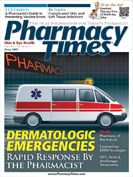Publication
Article
Pharmacy Times
Case Studies
CASE 1
CJ is a 30-year-old woman who presents to her primary care physician (PCP) complaining of generalized fatigue, low-grade fevers, headaches, and a rash on her upper arm in the shape of a “bullseye” (erythema migrans). CJ lives in New England and spends a great deal of time outside, particularly hiking and camping. Approximately 3 days ago, CJ noticed a tick attached to her arm, which she promptly removed and identified online as a blacklegged tick. Her PCP draws a sample of blood, which tests positive for Lyme disease. Her physician would like to initiate therapy for her Lyme disease, but is concerned because CJ exhibited intolerance (severe vomiting/diarrhea) to doxycycline in the past. CJ is otherwise healthy, with no other medication allergies or intolerances, and is not currently taking any prescription medications.
Which antibiotic would you recommend to treat CJ’s Lyme disease?
Answer:
Lyme disease is caused by the bacterium Borrelia burgdorferi and is commonly transmitted to humans through the bite of infected blacklegged ticks (Ixodes scapularis), which are indigenous to the northeastern United States. Lyme disease is commonly treated using the tetracycline antibiotic doxycycline for a course of 14 days (range of 10-21 days) for early nondisseminated disease. If the infection is left untreated, it may spread to the joints, heart, and nervous system.
In patients who are allergic or intolerant to doxycycline, the Centers for Disease Control and Prevention recommends the alternative antibiotics amoxicillin or cefuroxime axetil for an average treatment course of 14 days (range of 10-21 days).
Based on the fact that CJ does not have any other medication allergies or intolerances and is currently not taking any other prescription medications, either amoxicillin 500 mg 3 times daily or cefuroxime axetil 500 mg twice daily would be appropriate choices to treat her Lyme disease.
CASE 2
LF is a 64-year-old woman, who was recently involved in a car accident from which she suffered substantial injuries. LF was rushed to the hospital and is currently being treated in the medical intensive care unit (MICU). LF’s vital signs and laboratory values are stable/normal with the exception of a blood glucose of 240 mg/dL. Her doctors are concerned about her hyperglycemia because it can lead to lead to immunosuppression, poor wound healing, and an increased risk of morbidity and mortality. LF’s doctors contact you, the clinical pharmacist, for help managing her hyperglycemia. LF has a past medical history significant for hypertension, hyperlipidemia, and asthma, for which she is prescribed hydrochlorothiazide, atorvastatin, and a corticosteroid inhaler (fluticasone).
What is the most appropriate way to manage LF’s hyperglycemia?
Answer:
Inpatient hyperglycemia is associated with increases in hospital stays and costs as well as poorer health outcomes, including increased mortality.
Hyperglycemia, with or without diabetes, in hospitalized patients is primarily managed by intravenous insulin therapy. However, the newest (2011) American College of Physicians (ACP) guidance recommends avoiding intensive insulin therapy (targeted blood glucose level of 80-110 mg/dL) in surgical intensive care unit (SICU)/MICU patients or non-SICU/MICU patients, regardless of diabetes status (Grade: strong recommendation, moderate-to-high-quality evidence). Instead, the ACP guidance recommends a target blood glucose level of 140 to 200 mg/dL when insulin therapy is used in SICU/MICU patients (Grade: weak recommendation, moderate-quality evidence).
The pharmacist should recommend that LF’s physicians aim for a blood glucose between 140 and 200 mg/dL to avoid complications from both hyper- and hypoglycemia.
To submit your recommended approaches to the latest Case Studies, go to www.PharmacyTimes.com/Interactives. You'll be entered to win an iPad! (Registration required.)
Dr. Coleman is associate professor of pharmacy practice and director of the pharmacoeconomics and outcomes studies group at the University of Connecticut School of Pharmacy.
Mr. Caranfa is a PharmD candidate from the University of Connecticut School of Pharmacy.







